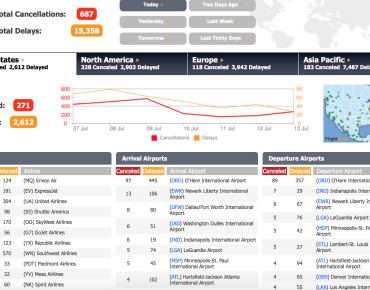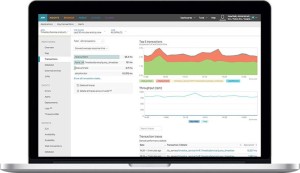New Relic Analytics Help FlightStats Soar

FlightStats provides real-time data about airlines, airports, and more.
Every day, throughout the world, millions of consumers, travel agencies, airlines, airports, and developers get real-time flight information from FlightStats, allowing people and packages to travel more efficiently.
But the Portland, Ore.-based company initially used multiple applications to gain visibility into its data – and that hurt efficiency, effectiveness, and costs.
"We were using five or six different tools across our stack and it was a mess. If I wanted to know if one of our APIs was up, I had to dig through to see which tool was monitoring it, and if it was being monitored at all," FlightStats Chief Technology Officer Chad Berkley told Enterprise Technology.
A couple of production outages had caught the company off-guard, he said. As the recently appointed CTO, Berkley refused to have this happen again on his watch, he said. In addition, valuable technologists spent too much time figuring out problems and dealing with overly complex monitoring systems.
"We have to know before our customers do that things are broken," said Berkley. "It's embarrassing."
Just as FlightStats' clients relied on a streamlined view to receive the provider's information, FlightStats sought a way to give internal users one source for multiple ways to find and view important information from its spectrum of sources, he said. But the solution had to seamlessly fit into FlightStats' two-tier Java-based technology stack, and its client-side mix of HTML5, CSS, and JavaScript, spread across private cloud and Amazon Web Services public cloud.
The answer, Berkley discovered: the New Relic Platform.
At first, FlightStats tested New Relic Servers, a free server-monitoring tool that gave FlightStats visibility into its entire server environment, Berkley said. In addition to ease of use, New Relic Servers provided insight into areas FlightStats had previously had none, he said.
"It was easy to install. Our developers didn't even know it was there. Our IT folk could easily monitor services," said Berkley. "I pushed it out to a few of our teams, the teams I consider cutting edge. They pushed it out to their application stacks. The data was easy to understand. Once we got a few early adopters on board we purchased APM and pushed it out across our servers. Even on our legacy servers we were able to get decent monitoring where we hadn't had it before."
New Relic's SaaS-based Application Performance Monitoring (APM) gave FlightStats much-needed visibility into its microservice architectures, allowing the company to understand how its distributed environments and applications performed. This allowed FlightStat teams to discern how customers experienced their service, recognize any problematic areas before issues arose, and enhance offerings, said Berkley.
Yet despite New Relic's sophistication, a complex rollout process does not burden IT, he noted.
"Before it was a pain to monitor things and there were a few people who knew how the monitoring system worked. If you needed something monitored, you found them and bribed them with candy or beer bec nobody wanted to learn," Berkley recalled. "Now it's part of our basic deployment. It's part of our cloud images. It's part of our virtual machine images. Whenever something is installed on our server [New Relic APM] goes out."
Organizations require one view into their complex architectures, said Bharath Gowda, director at New Relic, in an interview. Enterprises are breaking their architectures into microservices, using containers, adding virtual machines and middleware, which improve performance but add layers of complexity and potentially generate lack of visibility, he said.
"Doing all that in a vacuum and making sure your datacenter is working fine and Amazon's working great is nothing if your customers aren't happy. Customer experience is super-important, but the architecture has gotten super complex," Gowda said. "People have to move really fast; the old way of working in siloes just isn't working out."
FlightStats – which implemented the spectrum of New Relic solutions including New Relics APM, Browser, Insights, Mobile, Plugins, Server, and Synthetics – realized $300,000 in savings by gaining insight into areas of potential optimization, said Berkley. In addition, the company more than halved scraper traffic and redirected traffic to its paid APIs, he said.
While it's challenging to measure customer satisfaction, FlightStats proactively addresses any weaknesses in the system, fixing them before they break and affect clients, said Berkley. New Relic even helps FlightStats protect its clients' clients, he said.
"We've had a couple of big customers where their service, on their end, crashed and volumes had fallen off and we've emailed them or called them, told them about it. One larger customer said, 'Thanks, you knew before we did.' Those are the stories I like," said Berkley. "I can't think of a time within the past nine months where we've been surprised by anything…"
Internally, New Relic's technologies complement FlightStats' DevOps, agile environment, enabling all the company's executives and employees to speak one language, regardless of their responsibilities or area of focus, he noted. Dashboards are everywhere, Berkley joked, as FlightStats' use of data grew, thanks to New Relic's ease of use.
"We use Insights a lot. We have an unspoken rule that we measure everything. We're dumping lots and lots of events into Insights. It's easy enough to create dashboards. We've had non-technical users create dashboards," he said. "We have monitors bolted to the walls all over the place."
FlightStats continues to improve both its data usage and its tool kit, developing several open source tools include a node plug-in for New Relic Insight that the developer itself uses, said Berkley. "We've got a really great software team here, a team that's interested in giving back to the development community," he said.
Related
Managing editor of Enterprise Technology. I've been covering tech and business for many years, for publications such as InformationWeek, Baseline Magazine, and Florida Today. A native Brit and longtime Yankees fan, I live with my husband, daughter, and two cats on the Space Coast in Florida.











